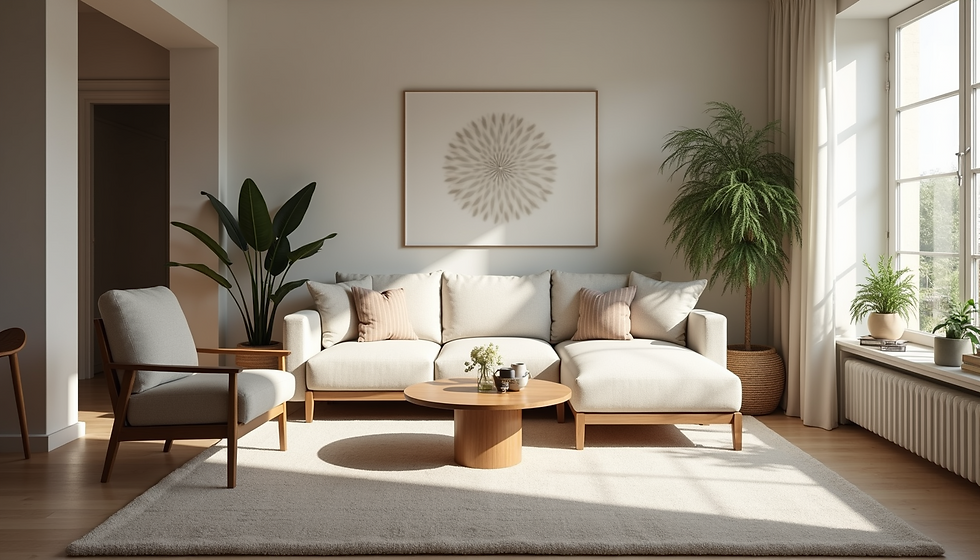Mastering Space Planning: Tips for a Functional Haven
- Mia Ray
- Mar 15
- 4 min read
Updated: Jul 10
Space Planning
Understand Your Space
To start any space planning project, it’s essential to get a clear understanding of your area. Take precise measurements with a tape measure, noting key architectural features like windows, doors, and built-ins. For example, if you’re working with a small bedroom measuring 3x3.5 meters, knowing the locations of windows can help you decide where to place your bed to maximise natural light.
Creating a floor plan can greatly enhance your approach. Use graph paper or design software to visualise your space. It's important to consider pathways for movement. Designating at least 75 cm of free space for walkways ensures easy movement between furniture pieces.

Define Functionality
Every area serves a purpose. Clearly defining the activities that will occur in the space guides your design decisions. For example, if you need a home office that doubles as a guest room, you’ll want furniture that is adaptable and fits the dual purpose without sacrificing comfort.
Creating zones within your space can enhance its functionality. In a small apartment, you can allocate sections for dining, working, and lounging. A dining table that folds down can be tucked away when not in use, while a sofa bed can accommodate guests comfortably without taking up too much space.
Choose Your Furniture Wisely
Selecting the right furniture is crucial in space planning. Choose pieces that suit the dimensions of your room. Multipurpose furniture can be a game changer. For instance, a coffee table with built-in storage can help keep your living area decluttered.
Carefully consider your furniture layout. Aim to have at least 45 cm between the coffee table and sofa to allow for easy movement. Don’t hesitate to try different arrangements; sometimes, simply relocating a single chair can make the space feel much more open and inviting.

Optimise Vertical Space
When floor space is tight, think vertically. Utilising wall space can free up valuable square meters. Consider installing floating shelves or tall bookshelves to capitalise on vertical storage. For instance, using upward storage solutions in a kitchen, like hanging pot racks, can clear up counter space and create a more organised cooking area.
Incorporating tall plants or wall art can draw the eye upward, creating an impression of height and spaciousness. Using mirrors can be an effective way to reflect light and create an illusion of depth in a room.
Keep It Light and Airy
Your color choices and lighting greatly affect how spacious a room feels. Light colors, like whites, pastels, and soft neutrals, can make a room appear larger. For example, painting small rooms in shades of soft gray or off-white can enhance brightness and openness.
Natural light is essential. Using sheer curtains can let more light in while maintaining privacy. A study found that maximising natural light can improve mood and productivity by up to 20%. Incorporate layered lighting ambient, task, and accent to give your space depth and warmth.
Plan for Storage
Keeping a space organised can prevent clutter from taking over. Smart storage solutions are vital for good space planning. Identify frequently used items and make them easily accessible while keeping rarely used items out of sight.
Utilize hidden storage options, like under-bed storage bins or built-in cabinets, to keep your space looking sleek. For added style, consider using decorative baskets that blend with your decor, offering both function and aesthetic appeal.
Personalise Your Space
Once your layout and functionality are sorted, it's time to infuse your space with personal touches. Decorate with items that reflect your personality. For example, using vibrant throw pillows, a colorful area rug, or framed art that resonates with you can make your space feel truly your own.
Personalisation not only enhances the beauty of your space but also creates a sense of comfort and belonging. This is where the concept of space planning really shines; it's not just about how your space looks, but also how it makes you feel.
Test the Arrangement
After you've planned your space and set up the furniture, it’s important to evaluate your layout. Walk around the space to ensure a smooth flow of movement. Take a moment to sit in different areas to gauge overall comfort. Don’t hesitate to rearrange items if necessary; small adjustments can lead to significant enhancements in livability.
Final Touches
Once you’re happy with the layout, it's time for those finishing touches. Add decorative elements like plants or artwork to elevate the atmosphere without overcrowding. Ensure that your lighting is well-distributed and consider practical details, such as the convenience of outlets for charging devices.
Your goal is to create a cohesive environment where functionality meets style.
Wrapping It Up
Mastering space planning goes beyond arranging furniture; it is a thoughtful process that balances function, style, and personal expression. By understanding your space, defining its purpose, and making intentional choices in furniture and decor, you can transform any area with confidence.
Whether dealing with a cozy studio, a family home, or a backyard retreat, these tips will help you create spaces that feel personalized and inviting. Embrace the art of space planning, and watch how your surroundings enhance your quality of life.
Happy planning!



Comentários